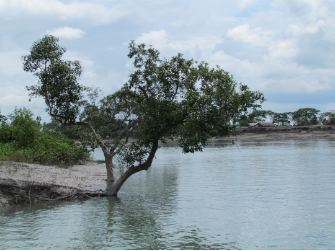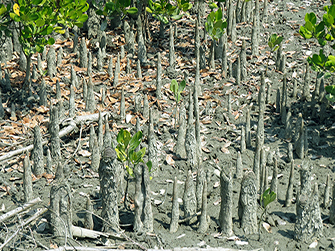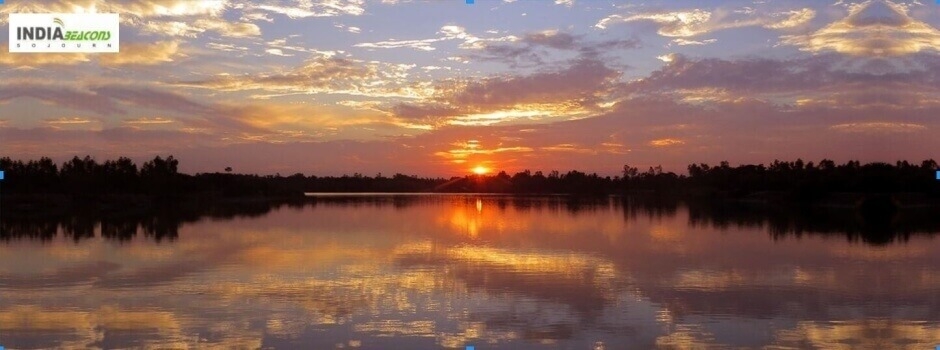Sundarbans National Park, India|Sundarbans Tiger Reserve, India|Sundarbans Delta, India

Sundarbans|Sunderbans National Park
Formed by the confluence of the mighty rivers – the Ganges, the Brahmaputra and the Meghna – the Sunderbans are a part of the world's largest delta situated on the lower end of the Gangetic West Bengal. It is also the world’s largest estuarine forest crisscrossed by hundreds of creeks and tributaries, intersected by a network of tidal waterways, small islands of salt-tolerant mangrove forests and mudflats.
The interconnected network of waterways makes almost every nook and corner of the forest accessible by boats or rafts making it one of the most attractive and alluring places on earth and an undiscovered paradise.
The Sunderban cruise through the Sundarbans National Park is one of the most memorable experiences of a lifetime. Such is its beauty that it was among the top 10 finalist of the "new7wonders of the world".
Sundarbans|Sunderbans : How to Reach
Sundarbans National Park can be reached by rail, road and air. Sundarbans is around 110 kms from Kolkata by road. However, we at India Beacons arrange for your transfer from Kolkata as part of our tour packages.
The nearest airport is the Netaji Subhash Chandra Bose Airport at Kolkata (112 kms). It takes around 3 hours of road journey from Kolkata and 2 hours of boat ride to reach Sundarbans.

Sundarbans|Sunderbans : Political geography
The physiography of the Sundarbans is dominated by a vast and remote land mass, criss crossed with rivers, creeks and tidal channels. Road network and human habitation ends at North and North West fringe of the mangrove forest and further entry into the forest is only via water through boats. The temperature in Sunderbans.
The soil of the Sundarbans is prone to high tide and low tide twice in a day and the salinity of the Indian part of Sunderbans i is higher that its Bangaledesh counterpart.
Sundarbans|Sunderbans:Tourist Attractions
The area of Sundarban National Park (1330 sq km) and the three watchtowers mainly Sajnekhali, Sudhanyakhali and Dobanki are most commonly visited by the tourists. Other than that there are a number of watchtowers which are also visited by tourists, namely the Netidhopani Watch Tower, The Burirdabri and Jhingakhali Watchtower.
Sundarbans has its universal appeal as it is a habitat for globally endangered species including the Royal Bengal Tiger, Irawadi Dolphins, estuarine crocodiles, marine turtles, species of shark and ray and the critically endangered endemic river terrapin (Batagur Baska)

Sundarbans ... a glimpse .
Sundarbans, the land of boundless beauty and magnificent landscapes named after the ubiquitous Sundari trees which were found there in large numbers, is the largest single block of tidal halophytic mangrove forest in the world and has the honor of being a UNESCO World Heritage Site & a Biosphere Reserve. The Sundarban forest covers around 10,000 sq.km of which a major portion is in Bangladesh, while the Indian portion is estimated at around 4264 square km.
The Sundarbans National Park still remains an enigma for all nature lovers who want to visit it at least once in their life time. Amitav Ghosh's "The Hungry Tide" has given it a new perspective and beckons one to visit the forests at least once. Apart from being a unique largest mangrove ecosystem of the world, the Sundarbans has the world’s largest deltaic mangrove forests and is also home to one of India’s most iconic wildlife species – the Royal Bengal Tiger.

Sundarbans|Sunderbans : Flora and Fauna
Sundarbans has a wide vaiety of flora and fauna. There are 334 plant species belonging to 245 genera and 75 families, 165 algae and 13 orchid species. All these have the capacity to withstand estuarine conditions and saline inundation on account of tidal effects. The most common species are : Hatal (Phoenix paludosa), Genwa (Excoecaria agallocha), Dhundul (Xylocarpus granatum), Kankra (Bruguirea gymnorrhiza), Champa(Bruguiera parviflora), Dhani ghas (Porteresia coarctata), Garjan (Rhizophora apiculata), Keora (Sonneratia apelata), Sundari tree (Heritiera fomes), Golpati(Nypa frutcans).
Sundarbans is also rich in fauna with 693 species of wildlife, which includes mammals, reptiles, amphibians, white fishes, shrimps, crabs etc. Banks of these rivers are favorite spot for the fauna of the region and one can easily spot animals It is always advisable to visit these places either during sunset or during sunrise. Tiger, Fishing Cat, Chital, Wild Boar, Water Monitor, Estuarine Crocodiles are found here.

